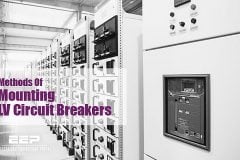Protection and limitation
Standard BS EN 60439 Part 1, describes a system for classifying the various forms of separation to be provided principally for:
- protection against contact with live parts belonging to the adjacent functional units.
- limitation of the probability of initiating arc faults.
- protection against the passage of solid foreign bodies from one unit of an Assembly to an adjacent unit.
Even though the Standard has now been revised with a UK National Annex to provide a wider scope of forms, it still does not give detailed advice on how to achieve these aims.
Manufacturers of switchboard assemblies employ many variations of design to meet this protection and any other additional market requirements. The means utilized to achieve these conditions may be partitions or barriers of metallic or non-metallic material. The partitions or barriers may provide individual separate compartments or alternatively, barriered sub-sections.
Greater clarification has been included within this guide by providing some basic definitions of the terms used and explaining some of the various methods employed by manufacturers to meet the required degree of separation. In general, the cost of an Assembly increases with enhanced levels of separation, but choosing the most expensive arrangement will not necessarily lead to the most appropriate solution.
Useful Definitions
The Standard includes definitions relating to Assemblies. Those particularly relevant to the separation of Assemblies include the following. The same clause numbering has been used to aid cross reference to the Standard.
Assembly
This includes floor standing or wall mounting distribution switchboards, panelboards, and motor control centres using electromechanical and/or electronic components. It does however specifically exclude individual devices and self-contained components which control a single circuit i.e., wall mounted starters and fuse switches.
Functional Unit
Essentially this is all parts necessary to form a complete incoming or outgoing circuit. It includes all the main current carrying equipment, including cable terminals, and control devices within the assembly, that are necessary to form the complete circuit. It excludes the connections from the unit to the busbars (busbar connections) and any insulation or shrouding with which they may be provided with.
(Generally such connections have a short-circuit rating to match the rated current and short-circuit characteristics of the functional unit and historically were referred to as ‘fault free zones’).
Section
Usually considered to be a single full height column containing one or more functional units. Generally several columns are required to complete an Assembly
Sub-Section
Abstract in nature. The area or space within a column identified and bounded by two adjacent and horizontal constructional members e.g., cross members or shelves.
Compartment
An enclosed area or space within an Assembly. Also includes a product complete with its own integral housing (MCB, MCCB, Moulded Switch, ACB) if protection to IP2X is assured.
Enclosure
Partition
A component used to form the top, bottom, sides, front or back of a compartment or enclosure and which can be manufactured from metal or an appropriate plastic material.
Barrier
Prevents finger contact with live parts and/or protects operators from emissions from switching devices. It can take the form of insulating material in direct contact with the live part, e.g., heat shrink sleeving on a busbar.
Alternatively it can take the form of rigid insulation or an earthed metal screen appropriately positioned relative to the live part(s).
Copyright Notice
This technical article is protected by U.S. and international copyright laws. Reproduction and distribution of PDF version of this technical article to websites such as Linkedin, Scribd, Facebook and others without written permission of the sponsor is illegal and strictly prohibited.© EEP-Electrical Engineering Portal.
Related electrical guides & articles
Premium Membership
Edvard Csanyi
Hi, I'm an electrical engineer, programmer and founder of EEP - Electrical Engineering Portal. I worked twelve years at Schneider Electric in the position of technical support for low- and medium-voltage projects and the design of busbar trunking systems.I'm highly specialized in the design of LV/MV switchgear and low-voltage, high-power busbar trunking (<6300A) in substations, commercial buildings and industry facilities. I'm also a professional in AutoCAD programming.
Profile: Edvard Csanyi











Hi Edvard,
I am interested in learning autocad designing for MV/LV circuits. can you guide me on that?
pleaseeeeeeeeee
I just join this organization as subscription for articles and all that…. However, this site is super, well done professionals. I hope to add my articles on this site one day. Thank Edvard and co.
Thanks man! You welcome to contribute in any way!!